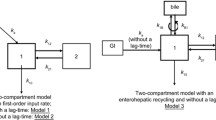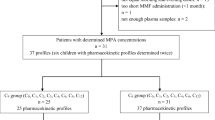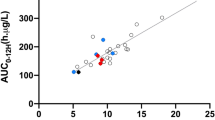Abstract
Background and Objective
Mycophenolate mofetil is a prodrug of mycophenolic acid (MPA), an immunosuppressive agent used in combination with corticosteroids and calcineurin inhibitors or sirolimus for the prevention of acute rejection after solid organ transplantation. Although MPA has a rather narrow therapeutic window and its pharmacokinetics show considerable intra- and interindividual variability, dosing guidelines recommend a standard dosage regimen of 0.5–1.0g twice daily in adult renal, liver and cardiac transplant recipients. The main objective ofthe present study was to develop a method to predict the MPA area under the plasma concentration-time curve during one 12-hour dosing interval (AUC12) by using multiple linear regression models and maximum aposteriori (MAP) Bayesian estimation methods in patients co-medicated with ciclosporin or sirolimus, aiming to individualize the dosage regimen of mycophenolate mofetil.
Patients and Methods
Pharmacokinetic profiles of MPA and mycophenolic acid glucuronide (MPAG), the main metabolite of MPA, were obtained from 40 stable adult renal allograft recipients on three different occasions: the day before switching from ciclosporin to sirolimus co-medication (±7.4 months posttransplantation; period I) and at 60 days and 270 days after the switch (periods II and III). Blood samples for determination of MPA and MPAG concentrations in plasma were taken at 0 hours (pre-dose) and at 0.33, 0.66, 1.25, 2, 4, 6, 8 and 12 hours after oral intake ofmycophenolate mofetil. The MPA AUC12 was calculated by the trapezoidal method (the observed AUC12). Patients were randomly divided into (i) a model-building test group (n = 27); and (ii) a model-validation group (n = 13). Multiple linear regression models were developed, based on three sampling times after drug administration. Subsequently, a population pharmacokinetic model describing MPA and MPAG plasma concentrations was developed using nonlinear mixed-effects modelling and a Bayesian estimator based on the population pharmacokinetic model was used to predict the MPA AUC12 based on three sampling times taken within 2 hours following dosing.
Results
Fifty-two percent ofthe observed AUC12 values (three periods) in the 40 patients receiving a fixed dose of mycophenolate mofetil 750mg twice daily were outside the recommended therapeutic range (30–60 mg • h/mL). The failure of the standard dose to yield an AUC12 value within the therapeutic range was especially pronounced during the first study period. Of the multiple linear regression models that were tested, the equation based on the 0-hour (pre-dose), 0.66- and 2-hour sampling times showed the best predictive performance in the validation group: r2 = 0.79, relative root mean square error (rRMSE)= 14% and mean relative prediction error (MRPE) = 0.9%. The pharmacokinetics of MPA and MPAG were best described by a two-compartment model with first-order absorption and elimination for MPA, plus a compartment for MPAG, also including a gastrointestinal compartment and enterohepatic cycling in the case of sirolimus co-medication. The ratio of aminotransferase liver enzymes (AST and ALT) and the glomerular filtration rate significantly influenced MPA glucuronidation and MPAG renal excretion, respectively. Bayesian estimation ofthe MPA AUC12 based on 0-, 1.25- and 2-hour sampling times predicted the observed AUC12 values ofthe patients in the validation group, with the following predictive performance characteristics: r2 = 0.93, rRMSE= 12.4% and MRPE = -0.4%.
Conclusion
Use ofthe developed multiple linear regression equation and Bayesian estimator, both based on only three blood sampling times within 2 hours following a dose of mycophenolate mofetil, allowed an accurate prediction ofa patient’s MPA AUC12 for therapeutic drug monitoring and dose individualization. These findings should be validated in a randomized prospective trial.













Similar content being viewed by others
References
European Mycophenolate Mofetil Corporate Study Group. Placebo-controlled study of mycophenolate mofetil combined with cyclosporine and corticosteroids for prevention of acute rejection. Lancet 1995; 345: 1321–25
Langman LJ, LeGatt DF, Yatscoff R. Pharmacodynamic assessment of mycophenolic acid-induced immunosuppression by measuring IMP dehydrogenase activity. Clin Chem 1995; 41: 295–9
Allison AC, Eugui EM. The design and development ofan immunosuppressive drug, mycophenolate mofetil. Semin Immunopathol 1993; 14: 353–80
Hale MD, Nicholls AJ, Bullingham RES, et al. The pharmacokinetic-pharmacodynamic relationship for mycophenolate mofetil in renal transplantation. Clin Pharmacol Ther 1999; 64: 672–83
Staatz CE, Tett SE. Clinical pharmacokinetics and pharmacodynamics of mycophenolate in solid organ transplant recipients. Clin Pharmacokinet 2007; 46: 13–58
van Gelder T, Hilbrands LB, Vanrenterghem Y, et al. A randomized double-blind, multicenter plasma concentration controlled study of the safety and efficacy of oral mycophenolate mofetil for the prevention of acute rejection after kidney transplantation. Transplantation 1999; 68: 261–6
Cellcept (mycophenolate mofetil) 500mg powder: summary ofproduct characteristics. Welwyn Garden City: Roche Products Limited, 2009 Jun 8 [on-line]. Availablefrom URL: http://emc.medicines.org.uk/medicine/1681/SPC/Cellcept+500mg+Powder/ [Accessed 2009 Sep 11]
Shaw LM, Sollinger HW, Halloran P, et al. Mycophenolate mofetil: a report of the consensus panel. Ther Drug Monit 1995; 17: 690–9
Johnson AG, Rigby RJ, Taylor PJ, et al. The kinetics ofmycophenolic acid and its glucuronide metabolite in adult kidney transplant recipients. Clin Pharmacol Ther 1999; 66: 492–500
Bullingham R, Monroe S, Nicholls AJ, et al. Pharmacokinetics and bioavailability of mycophenolate mofetil in healthy subjects after single oral and intravenous administration. J Clin Pharm 1996; 36: 315–24
Wollenberg K, Krumme B, Schollmeyer P, et al. Pharmacokinetics ofmycophenolic acid after renal transplantation. Transplant Proc 1998; 30: 2237–9
Mourad M, Malaise J, Chaib Eddour D, et al. Correlation ofmycophenolic acid pharmacokinetic parameters with side effects in kidney transplant patients treated with mycophenolate mofetil. Clin Chem 2000; 47: 88–94
Sennesael JJ, Bosmans JL, Bogers JP, et al. Conversion from cyclosporine to sirolimus in stable renal transplant recipients. Transplantation 2005; 80:1578–85
Pawinski T, Hale MD, Korecka M, et al. Limited sampling strategy for the estimation of mycophenolic acid area under the curve in adult renal transplant patients treated with concomitant tacrolimus. Clin Chem 2002; 48: 1497–504
Lindbom L, Pihlgrem P, Jonsson EN. PsN-toolkit: a collection of computer intensive statistical methods for non-linear mixed effect modeling using NONMEM. Comput Methods Programs Biomed 2005; 79: 241–57
Jonsson EN, Karlsson MO. Xpose: an S-Plus based population pharmacokinetic/pharmacodynamic building aid for NONMEM. Comput Methods Programs Biomed 1999; 58: 51–64
Hu TM, Hayton WL. Allometric scaling ofxenobiotic clearance: uncertainty versus universality. AAPS Pharm Sci 2001; 3: 1–15
Hooker AC, Staatz CE, Karlsson MO. Conditional weighted residuals (CWRES): a model diagnostic for the FOCE method. Pharm Res 2007; 24: 2187–97
Cockcroft DW, Gault MH. Prediction of creatinine clearance from serum creatinine. Nephron 1976; 16: 31–41
Nankivell BJ, Gruenewald SM, Allen RD, et al. Predicting glomerular filtration rate after kidney transplantation. Transplantation 1995; 59: 1683–9
Prémaud A, Le Meur Y, Debord J, et al. Maximum a posteriori Bayesian estimation of mycophenolic acid pharmacokinetics in renal transplant recipients at different postgrafting periods. Ther Drug Monit 2005; 27: 354–61
Le Guellec C, Bourgoin H, Büchler M, et al. Population pharmacokinetics and Bayesian estimation of mycophenolic acid concentrations in stable renal transplant patients. Clin Pharmacokinet 2004; 43: 253–66
Sheiner LB, Beal SL. Some suggestions for measuring predictive performance. J Pharmacokinet Biopharm 1981; 9: 503–12
Bland JM, Altman DG. Statistical methods for assessing agreement between two methods ofclinical measurement. Lancet 1986; I: 307–10
Willis C, Taylor PJ, Salm P, et al. Evaluation oflimited sampling strategies for estimation of12-hour mycophenolic acid area under the plasma concentration-time curve in adult renal transplant patients. Ther Drug Monit 2000; 22: 549–54
Yeung S, Tong KL, Tsang WK, et al. Determination ofmycophenolate area under the curve by limited sampling strategy. Transplant Proc 2001; 33:1052–3
Zicheng Y, Xianghui W, Peijun Z, et al. Evaluation of the practicability of limited sampling strategies for the estimation ofmycophenolic acid exposure in Chinese adult renal recipients. Ther Drug Monit 2007; 29: 600–6
Filler G, Mai I. Limited sampling strategy for mycophenolic acid area under the curve. Ther Drug Monit 2000; 22: 169–73
Figurski MJ, Nawrocki A, Pescovitz MD, et al. Development ofa predictive limited sampling strategy for estimation ofmycophenolic acid area under the concentration time curve in patients receiving concomitant sirolimus or cyclosporine. Ther Drug Monit 2008; 30: 445–55
Shum B, Duffull SB, Taylor PJ, et al. Population pharmacokinetic analysis of mycophenolic acid in renal transplant recipients following oral administration ofmycophenolate mofetil. Br J Clin Pharmacol 2003; 56: 188–97
Jiao Z, Ding JJ, Shen J, et al. Population pharmacokinetic modelling for enterohepatic circulation ofmycophenolic acid in healthy Chinese and influence of polymorphism in UGT1A9. Br J Clin Pharmacol 2008; 65: 893–907
Cremers S, Schoemaker R, Scholten E, et al. Characterizing the role of enterohepatic recycling in the interactions between mycophenolate mofetil and calcineurin inhibitors in renal transplant patients by pharmacokinetic modelling. Br J Clin Pharmacol 2007; 10: 249–56
van Hest RM, Mathot RAA, Pescovitz MD, et al. Explaining variability in mycophenolic acid exposure to optimize mycophenolate mofetil dosing: a population pharmacokinetic meta-analysis of mycophenolic acid in renal transplant recipients. J Am Soc Nephrol 2006; 17: 871–80
Staatz CE, Dufull SB, Kiberd D, et al. Population pharmacokinetics of mycophenolic acid during the first week after transplantation. Eur J Clin Pharmacol 2005; 61: 507–16
van Hest RM, van Gelder T, Vulto AG, et al. Population pharmacokinetics of mycophenolic acid in renal transplant recipients. Clin Pharmacokinet 2005; 44: 1083–96
Kuypers DR, Verleden G, Naesens M, et al. Drug interaction between mycophenolate mofetil and rifampin: possible induction of uridine diphosphate glucurosyl-transferase. Clin Pharmacol Ther 2005; 78: 81–8
Hesselink DA, Van Hest RM, Mathot RAA, et al. Cyclosporine interacts with mycophenolate mofetil by inhibiting the multidrug resistance-associated protein 2. Am J Transplant 2005; 5: 987–94
van Gelder T, Klupp J, Barten MJ, et al. Comparison of the effects of tacrolimus and cyclosporine on the pharmacokinetics ofmycophenolic acid. Ther Drug Monit 2001; 23: 119–28
Le Meur Y, Buchler M, Thierry A, et al. Individualized mycophenolate mofetil dosing based on drug exposure significantly improves patient outcomes after renal transplantation. Am J Transplant 2007; 7: 2496–503
Acknowledgements
No sources of funding were used to assist in the preparation of this study. The authors have no conflicts of interest that are directly relevant to the content of this study.
Author information
Authors and Affiliations
Corresponding author
Rights and permissions
About this article
Cite this article
Musuamba, F.T., Rousseau, A., Bosmans, JL. et al. Limited Sampling Models and Bayesian Estimation for Mycophenolic Acid Area under the Curve Prediction in Stable Renal Transplant Patients Co-Medicated with Ciclosporin or Sirolimus. Clin Pharmacokinet 48, 745–758 (2009). https://doi.org/10.2165/11318060-000000000-00000
Published:
Issue Date:
DOI: https://doi.org/10.2165/11318060-000000000-00000




